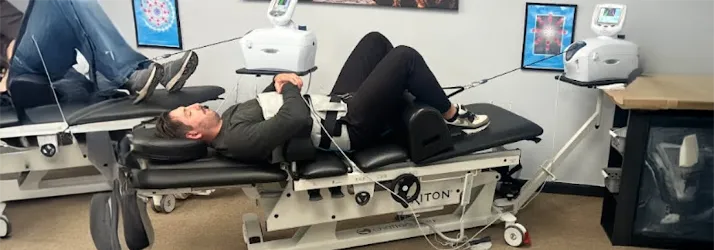We Tried Spinal Decompression Therapy: The Results Surprised Us in Salinas STATE*
We Tried Spinal Decompression Therapy: The Results Surprised Us in Salinas CA

We Tried Spinal Decompression Therapy: The Results Surprised Us
In a review of 31 clinical studies on lumbar disc herniation, researchers found that non-invasive treatments like spinal decompression therapy often leads to real, measurable healing. The data showed 96% of sequestrated discs, 70% of extrusions, and 41% of protrusions showed signs of regression on imaging.
Even more striking, 43% of sequestrated discs and 15% of extruded discs had fully resolved on follow-up scans. That’s not theory, it's an objective change in the spine after conservative care.
But conservative doesn’t mean passive. For years, spinal decompression has been grouped in with general traction. But NSDT or non-surgical spinal decompression therapy is different.
I’ve seen patients respond to it firsthand. In this guest post, we’ll look into how spinal decompression actually works, what sets it apart and why it might be the missing link for many patients.
What Is Spinal Decompression Therapy ?
Spinal decompression therapy is a modern, non-surgical way to relieve pressure on the spine caused by herniated discs and many more back ailments. While traditional traction had its place, it lacked control. Patients often tensed up during treatment, which reduced its effectiveness.
At The Disc Chiropractic in Wheat Ridge, CO, we use a computer-guided decompression system that adjusts in real time based on how your spine responds.
Here’s how it works:
- You’re gently secured to a specialized table, with supports placed at the upper and lower body.
- The table isolates the specific disc level that needs attention. We set the angle and traction force based on your imaging and exam findings.
- The system begins a controlled pull, stretching the spine slowly and gradually. This avoids triggering muscle guarding.
- Negative pressure builds inside the disc—often reaching 100 mmHg or more. That drop in pressure helps retract the herniation away from the nerve root.
- Fluids and nutrients move back into the disc, helping with rehydration and recovery.
- Pressure is taken off surrounding nerves and joints, which leads to improved movement and less pain.
Most patients describe it as a comfortable, almost relaxing experience. Over several sessions, this controlled decompression can help the disc regain height, reduce inflammation, and relieve nerve compression.
What the Research Found Spinal Decompression Therapy
In a controlled trial, researchers looked at 60 patients with lumbar disc herniation. Half received non-surgical spinal decompression therapy ten times over eight weeks. The other half received pseudodecompression, basically a placebo.
What they found confirmed what many of us in the clinic already suspected: real decompression creates real change.
Here’s what stood out:
- Leg pain dropped more in the decompression group than in the sham group by the two-month mark.
- Disability scores used to measure daily function were also better in the decompression group at both two and three months.
- And most important of all: MRI changes were significant.
Patients who received spinal decompression showed a 27.6% reduction in disc herniation index. In contrast, the placebo group only showed a 7.1% reduction. Even more telling, 26.9% of patients in the decompression group had over 50% reduction in their disc herniation, while no one in the placebo group came close.
What this tells us is simple: spinal decompression isn’t just helping people feel better, it’s doing something meaningful to the disc itself. That’s a big deal. For years, conservative care has focused on pain relief.
How Does It Work Differently Than Traditional Traction?
The system we use at The Disc Chiropractic is designed to take human error and muscle resistance out of the equation. Here's what sets it apart:
Real-Time Feedback From Sensors
The table constantly monitors resistance during each pull. If your body starts to tighten or push back, the machine adjusts the force automatically. That keeps the treatment comfortable and stops your muscles from fighting it.
Relaxation Allows for Better Response
One of the biggest problems with old-school traction is that people tense up. When your muscles are guarding, the disc doesn’t get the decompression it needs. NSDT helps avoid that. It ramps up slowly, allowing the body to stay relaxed and the spine to stretch naturally.
Custom Angles and Directional Control
Every spine is different. Some disc herniations push back, others off to the side. NSDT lets us change the angle and direction of pull, so we can target the exact area that needs relief. That’s something manual traction just can’t do.
The “Zero-Gravity” Effect
During treatment, the spine is gently stretched in a way that simulates a weightless state. This helps reduce pressure on the joints, nerves, and discs, allowing fluid to move back into the disc space. There’s also evidence that it creates space around the posterior longitudinal ligament—a structure that helps hold disc material in place and can support retraction of herniated tissue.
Gradual Increases
Instead of hitting the spine with one strong pull, NSDT uses a stepwise increase in force over time. Each session builds on the last. That repeated exposure to controlled decompression helps the disc rehydrate, reduce inflammation, and begin structural repair.
What this all means is that spinal decompression isn’t just a “fancier” version of traction. It’s a smarter one. And for people with disc herniation and other back injuries, that makes a big difference.
Final Thoughts
Spinal decompression therapy has come a long way from the days of basic and passive pulling. Today, we’re working with systems that allow us to control everything right down to the individual disc level.
If you’ve been stuck in that middle space, wondering if anything can help without going under the knife, this might be the step you’ve been missing. We’ve helped patients get back to walking, working, and moving without fear of their back flaring up again.
And we’re ready to help you, too.
6990 W 38th Avenue, #205
Wheat Ridge, CO 80033
FAQs About Spinal Decompression Therapy
Is Spinal Decompression Therapy Painful?
No, it is not painful at all. Real-time sensors adjust tension based on your body’s response. This prevents sudden pulling or muscle guarding. If discomfort occurs, the settings can be adjusted immediately to reduce strain.
How Many Sessions Are Usually Needed?
Most patients with lumbar disc herniation respond best to 15 to 20 sessions spread over several weeks. This schedule allows the disc to respond gradually to repeated traction. Improvement is monitored throughout the process, and care is adjusted based on your body’s response.
Can Spinal Decompression Therapy Help With Sciatica?
Yes, spinal decompression therapy can help relieve sciatic pain when it’s caused by disc herniation. Sciatica happens when a lumbar disc presses on the nerve roots that travel into the leg. Decompression lowers pressure inside the disc, which can relieve nerve irritation and reduce pain radiating down the leg.
Monday
8:00am - 12:00pm
2:00pm - 6:00pm
Tuesday
8:00am - 12:00pm
Wednesday
8:00am - 12:00pm
2:00pm - 6:00pm
Thursday
8:00am - 12:00pm
2:00pm - 6:00pm
Friday
8:00am - 12:00pm
Saturday
Closed
Sunday
Closed
Smoot Family Chiropractic
34 Iris Dr
Salinas, CA 93906
P: (831) 751-3939
F: (831) 751-3901



